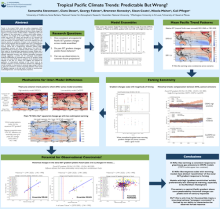Using Large Ensembles to Diagnose Drivers of Tropical Pacific Climate Sensitivity
Samantha
Stevenson
University of California, Santa Barbara
Poster
Climate models project a robust and consistent "El Nino-like" reduction of the sea surface temperature (SST) gradient under future warming scenarios, yet their inability to reproduce recently observed eastern Pacific cooling trends calls into question the accuracy of these projections. In order to reliably understand the extent of and mechanisms for inter-model differences in the forced response of tropical Pacific SST trends, estimates of that forced response using different models and scenarios of future climate change are required. Here we present analyses from a new compilation of large ensembles: over 14 different models and 6 different scenarios are included, allowing an accurate assessment of the forced trend across models and its sensitivity to the magnitude of projected future climate change. Systematic differences between models exist in the 21st century change in the equatorial Pacific SST gradient: when these trends are normalized using the global temperature increase, a relatively constant value is found for a given model. Inter-model differences in this "Tropical Pacific Climate Sensitivity" are related to coherent patterns of SST with loadings in the northeast subtropical Pacific and South Pacific Convergence Zone (SPCZ) region, as well as being associated with model bias in similar locations. These results imply that it may be possible to relate historical model performance with projections of future SST gradient changes, and thus potentially constrain the magnitude of projected changes more accurately.

Poster file
stevenson-samantha-confronting-poster.pdf
(11.56 MB)
